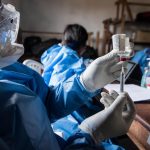Introduction Despite considerable improvements in vaccination coverage over the last decade, half of the world’s unvaccinated and undervaccinated children are located in Africa. The role of institutional trust in explaining vaccination gaps has been highlighted in several qualitative reports but so far has only been quantified in a small number of high-income countries.
Methods We matched information on child vaccination status from the Demographic Health Surveys with information on institutional trust from the Afrobarometer surveys at the subnational level. A total of 166 953 children from 41 surveys administered in 22 African countries covering 216 subnational regions were used. Based on a principal component analysis, we constructed an institutional mistrust index that combined the level of mistrust in the head of state, parliament, electoral system, courts and local government. Associations between institutional mistrust and child vaccination uptake were assessed with multivariable fixed effects logistic regressions that controlled for time-invariant subnational region characteristics and various child, caregiver, household and community characteristics.
Results A 1 SD increase in the institutional mistrust index was associated with a 10% (95% CI of ORs: 1.03 to 1.18) increase in the likelihood that a child had not received any of eight basic vaccines and with a 6% decrease in the likelihood a child had received all of the basic vaccines (95% CI: 0.92 to 0.97). Institutional mistrust was negatively associated with the likelihood that a child had received each of the eight basic vaccinations (p<0.05).
Conclusions Child vaccination rates in Africa are considerably lower in areas in which the local population displays high levels of mistrust towards local authorities. Institutional mistrust is an important dimension of vaccine hesitancy, considered as one of the most important threats to global health. Empowering local authorities with resources and communication strategies to address institutional mistrust may be needed to close the remaining vaccination gaps in Africa. Read more.
